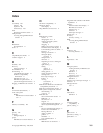key. The private key is kept on the user’s
system and is protected by a password. 2)
The secret half of a cryptographic key
pair that is used with a public key
algorithm. Private keys are typically used
to digitally sign data and to decrypt data
that has been encrypted with the
corresponding public key.
public key
1) In secure communication, an
algorithmic pattern used to decrypt
messages that were encrypted by the
corresponding private key. A public key is
also used to encrypt messages that can be
decrypted only by the corresponding
private key. Users broadcast their public
keys to everyone with whom they must
exchange encrypted messages. 2) The
non-secret half of a cryptographic key
pair that is used with a public key
algorithm. Public keys are typically used
to verify digital signatures or decrypt
data that has been encrypted with the
corresponding private key.
R
redirected distribution
A method of software distribution that
uses a file-distribution server.
remote I/O enclosure
An IBM Director managed object that
represents an expansion enclosure of
Peripheral Component Interconnect-X
(PCI-X) slots, for example, an RXE-100
Remote Expansion Enclosure. The
enclosure consists of one or two
expansion kits.
Remote Supervisor Adapter
An IBM service processor. It is built into
some xSeries servers and available as an
optional adapter for use with others.
When used as a gateway service
processor, the Remote Supervisor Adapter
can communicate with all service
processors on the Advanced System
Management (ASM) interconnect.
resolution
The occurrence of a correction or solution
to a problem.
resource-monitor threshold
The point at which a resource monitor
generates an event.
RXE Expansion Port
The dedicated high-speed port used to
connect a remote I/O expansion unit,
such as the RXE-100 Remote Expansion
Enclosure, to a server.
S
scalable node
A physical platform that has at least one
SMP Expansion Module. Additional
attributes are assigned to a physical
platform when it is a scalable node. These
additional attributes record the number of
SMP Expansion Modules, SMP Expansion
Ports, and RXE Expansion ports on the
physical chassis.
scalable object
An IBM Director managed object that is
used with Scalable Systems Manager.
Scalable objects include scalable nodes,
scalable systems, scalable partitions, and
remote I/O enclosures that are attached to
scalable nodes.
scalable partition
An IBM Director managed object that
defines the scalable nodes that can run a
single image of the operating system. A
scalable partition has a single, continuous
memory space and access to all associated
adapters. A scalable partition is the logical
equivalent of a physical platform. Scalable
partitions are associated with scalable
systems and comprise only the scalable
nodes from their associated scalable
systems.
scalable system
An IBM Director managed object that
consists of scalable nodes and the scalable
partitions that are composed of the
scalable nodes in the scalable system.
When a scalable system contains two or
more scalable nodes, the servers that they
represent must be interconnected through
their SMP Expansion Modules to make a
multinode configuration, for example, a
16-way System x 455 server made from
four scalable nodes.
Secure Sockets Layer (SSL)
A security protocol that provides
communication privacy. SSL enables
client/server applications to communicate
Glossary 285


















